Paperback originals have often been the forum for fiction that was a little off the beaten track; wild, nihilistic, edgy, and even a bit experimental. Writers like Chester Himes, David Goodis and Jim Thompson may be thought of as founding fathers of that school. It was a style of writing that couldn't be bothered with fancy cars and femmes-fatale with unlikely names.
Among the many paperback heroes, Donald Hamilton's Matt Helm is one of the longest-lived and most successful in the history of the genre. It is worth noting, as well, that Hamilton's influence on other writers is pervasive. Crime writers as diverse as Loren Estleman, Bill Crider, Ed Gorman, James Sallis, as well as myself, all consider him a primary influence on their writing.

Donald Bentgsson Hamilton was born in Uppsala, Sweden on March 24, 1916. In 1924 he and his parents immigrated to America, where his father, a medical doctor, served on the faculties of Harvard, Johns Hopkins, and the University of Chicago.
Hamilton, in a recently-published essay, says that he started school in his new homeland wearing something every Swedish schoolboy of his time carried as a matter of course--a small sheath knife. Horrified officials called his parents in for a consultation, and the knife disappeared. The experience was not lost on Hamilton, because two of the threads that run through his fiction are an affection for edged weapons and a disdain for bureaucracy.
Hamilton recounts that there was no dramatic turning point that caused him to be a writer. He began by keeping his kid sisters up at night telling scary stories "that I made up as I went along." In high school, he appropriated an old Underwood typewriter that his parents had stopped using, and got himself a book on touch typing, a purchase he now says "was the best couple of bucks I ever invested." He knew at the time he wanted to write, but his father counseled "that's fine, Donald, but you'd better have a way of earning a living, too." To that end, Hamilton enrolled in the University of Chicago, but he told Collier's Magazine in 1946 that his graduation from college was delayed a year because he was too busy "writing questionable fiction when [he] should have been writing incontrovertible facts."
Hamilton found his early inspiration in Dashiell Hammett, Hemingway and Raymond Chandler, and some perhaps unwanted influence from Leslie Charteris. Hamilton says, "I had to stop reading the Saint books . . . because I found that if I read one at night, everything I wrote next morning came out Leslie Charteris."
Hamilton joined the navy in 1942, was commissioned an officer, and spent the war at Annapolis doing chemical research. Two novels he wrote during that period failed to sell, but he cracked the lucrative slick magazine market in 1946 when he sold his first story to Collier's.
The sale was unexpected, since the editor kept sending it back for changes. "Between us," he says, "we rewrote that damn' little love story seven times. When still another letter came from Collier's I thought we were just shooting for revision eight . . . but when I opened the envelope out fell a check for seven hundred and fifty dollars!"
Nineteen-forty-seven brought Hamilton's first hard-cover sale, Date With Darkness, issued by Rinehart, and the publication of the novella "The Black Cross" in the influential American Magazine. As the titles suggest, each is classic noir, with unrelenting suspense, and a cast of characters who are rarely what they present themselves to be.
Hamilton's early preference for an essentially non-violent protagonist (often a recently-discharged or still-serving naval officer with no combat experience) who becomes more compentent and dangerous as the menace heightens, suggests the strong influence of both John Buchan's The Thirty-Nine Steps and Geoffrey Household's Rogue Male. Another similarity may be seen in Hamilton's use of assassination as a plot element.
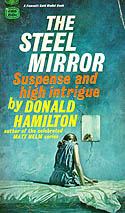
Hamilton's next triumph was The Steel Mirror. This story of an insecure chemist who becomes involved with a beautiful and enigmatic woman is noteworthy for the tension wrought by a cross-country car chase as the chemist tries to uncover the reason for the mysterious woman's flight, while protecting her from her unrelenting pursuers.
In 1953 Hamilton branched out, and began to write Westerns. Even so, Hamilton continued to fall back on the idea of an Everyman pulled into trouble by circumstances beyond his control. As before, assassination would continue to be the impetus for the hero's involvement.
Smoky Valley tells the story of John Parrish, an unassuming Easterner who has come west to recover from a bad wound received in the Civil War. Parrish's small size and his eastern sensibilities lead everyone in Logasa, New Mexico to underestimate, and even deride him. He bears this with quiet stoicism, because "he had become used to the way these people tended to dismiss as insignificant any man . . . unless he was at least six and a half feet tall and suitably wide to match." What the townspeople don't realize is that Parrish served as a captain of Union cavalry at the age of 20. The ten years since the war have mellowed a reckless youth into a man of grim and quiet resolve who is about to turn the "smoky valley" on its ear.
Parish is disturbed by the murder of the tough but elderly town marshal by men in the employ of cattle baron Lew Wilkinson, but as he is about to marry town belle Caroline Vail and take her back East, he remains aloof.
However, events occur that shake Parrish out of his complacency. He meets Judith Wilkison, the headstrong younger daughter of Lew Wilkison, and is intrigued by her forthrightness, and cool disdain for Parrish's perceived indifference. Presently, Parrish recognizes that Caroline's supposed love for him is no more than a cold-hearted ruse to escape Logasa, and that her heart really belongs to George Menefee, a dissolute lawyer.
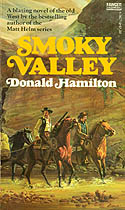
The final blow comes when the Pecos Kid, Anchor's top gun, kills one of Parrish's young cowboys. This insult, falling so close to home, focuses the disquiet Parrish has felt at the marshal's murder into a cold rage. Parrish tracks the hired gunslinger to a saloon, and, with ruthless effiency, kills the murderer.
The death of the gunslinger immediately makes Parrish a lightning rod for local animosity against Wilkison, and results in an alliance among smaller ranchers. At the conclusion, Parish transfers his affections to Judith Wilkison, who has stood beside him, gun in hand, through the worst of the danger.
Although Hamilton would publish only a few westerns, the themes in this novel would carry over into the others. Of his five westerns, three would feature as heroes transplanted Easterners unused to the ways of the West, but fully able to deal with them. James McKay of The Big Country is a tough clipper ship captain. Alexander Burdick, the hero of The Man From Santa Clara, is a photographer from Washington, D. C. who possesses an uncanny skill with the double-barrelled shotgun, and an almost suicidal relish of danger. Each has known or will experience romantic disappointments with women who were unworthy of them, and each finds true love with a two-fisted Western gal.
The latter two of Hamilton's Western protagonists are true Western cowboys, but they share the same quiet strength that enables them to vanquish their enemies and win the love of a good woman. Boyd Cohoon of Mad River returns from a term in prison to find his father and brother dead and his home town in the grip of Paul Westerman, a power-hungry rancher. His tenacity and his skill with a knife enables him to avenge his family's deaths and resurrect his own tarnished reputation. Along the way he survives the perfidy of Claire Paradine, who promised to wait for him, and finds love with Nan Montoya, a dance hall girl.
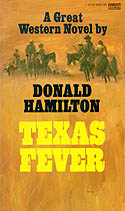
Chuck McAuliffe of Texas Fever takes over his father's cattle drive when the older man is murdered, and manages to both command the respect of his father's men and extract vengeance from the outlaw gang that murdered him.
A particularly interesting facet of Texas Fever is the character Amanda Netherton. Hamilton's westerns invariably feature two women to whom the hero is attracted, and a defining moment in each of the first four books is when the hero discovers that the original object of his desire is unworthy of him. Amanda is an outlaw, but she is not without conscience. After sexually initiating Chuck and receiving a marriage proposal in return, her regrets about the path her life has taken become so intense that she commits suicide. The tragedy provides the impetus for Chuck's defeat of villain Jack Keller, and clears the way for his later marriage to "good" girl Jean Kincaid.
However, Hamilton's real western breakthrough was The Big Country. This story of an Eastern ship captain who comes west to marry the daughter of a powerful rancher has a subtle brilliance to it. Jim McKay finds himself, against his will, embroiled in a land and water dispute between his prospective father-in-law, Major Terrill, and Old Rufus Hannessey.
Jim runs into trouble with his bride and her father when he seemingly avoids every opportunity to prove his manhood with guns, fists, and horses. Jim's impatience with western ways seems cowardly, but he stubbornly follows his own path, eventually realizing that Pat Terrill's doubts about his manhood make marriage to her an impossibility.
His growing friendship with Julie Maragon, Pat's best friend and owner of a crucial piece of land that both warring factions want because of the water that runs through it, eventually prompts Jim to purchase the land from Julie and make the water available to all. When Rufus Hannessey, unknowing of her sale of the land to Jim, kidnaps Julie, a violent showdown brews between Major Terrill and Rufus. Jim forces his way between the two factions, rescues Julie, and remains in Texas to marry her and build his own ranch.
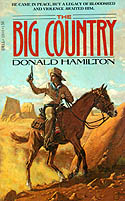
The book was adapted into a mammoth technicolor motion picture with an all-star cast that included Gregory Peck, Carroll Baker, Jean Simmons, Charleton Heston, Charles Bickford, and Burl Ives. The film was nominated for several academy awards, won awards for best musical score and best supporting actor (Burl Ives), and brought Donald Hamilton's name to the attention of the public like none of his previous books had.
Even during this particularly fertile period in the Western genre, Hamilton continued to create memorable work in the suspense field. In 1955 he published the first of two books that may be thought of as the foundation for the Matt Helm series. As Line of Fire opens, gunsmith and expert marksman Paul Nyquist is lining up the sights of a scoped rifle on a gubernatorial candidate in the streets below. The report of the rifle that, strangely, only wounds the candidate, is followed by the unexpected entry of an innocent woman into the room. A gunman accompanying Paul tries to kill the girl, but Paul inexplicably kills him first. Paul gets the girl out of town, and does his best to hide her involvement, eventually marrying her to insure her protection.
As the story unfolds, it becomes clear that Paul is in reluctant league with a gangster who is backing the candidate, and the attempted assassination was engineered to generate sympathy. It is clear that Paul despises the gangster, but there is a bond between them. Paul once saved his life during a hunting trip, but was injured, and rendered sexually impotent, during the rescue.
A sexually-available moll who belongs to the gangster also enters the scene, and it is apparent that she has been trying, unsuccessfully, to "cure" Paul of his impotence for some time. It is also apparent that Paul is a borderline suicide, seemingly waiting for the right set of circumstances to push him over the edge.
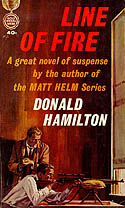
This motley cast of characters becomes a volatile mix as Paul and the gangster head toward a dramatic showdown. Of perhaps more interest is the ambivalent romantic relationship that brews between Paul and the young woman he has saved from murder. The story ends on a hopeful note, but with Paul's impotence left unresolved at the conclusion.
A number of Hamilton trademarks are on display here. The hero's familiarity with guns and knives (Nyquist is Hamilton's earliest hero to use a blade), his sardonic, self-mocking first-person narration, and the moral ambiguity that hangs over virtually every character makes the story perhaps one of Hamilton's most intriguing during this stage of his career.
The second of these "foundation" novels is Assignment: Murder. The novel opens as Dr. James Gregory, a mathematician with high-level government clearance, is shot while out hunting. Initially he thinks that he has been the victim of a hunter who has mistaken him for an animal. However, after the third shot, it becomes clear that the hunter has been hunting him. Drawing on a reserve of strength he didn't know he had, Gregory fires his own rifle at the assailant, and kills him with a single shot, still thinking that his assailant is nothing but "a trigger-happy hunter." A federal agent named Van Horn who visits him in the hospital isn't so sure.
Gregory's next visitor is his wife, Natalie, who has just returned from a Reno, where she went seeking a divorce. "She had been twenty when I married her," he says. "The whole thing had been a mistake, of course, but I could still think of arguments in its favor." It is evident from the conversation that follows that there is still a strong affection between the two of them.
Gregory's third visitor is Nina Rasmussen, the sister of the man who shot Gregory. She comes in with a gun, but Natalie spoils her aim, and then knocks her out with a vase.
An idyll with Natalie follows while Gregory recuperates, but when a close friend and colleague on Gregory's atomic research project is found murdered, and Gregory refuses to leave the project, Natalie decides to return to Reno and finish the divorce. Presently, her car is found wrecked, and she is missing. The deaths or disappearances of three others connected to Gregory's secret project add up to a conspiracy, both to Agent Van Horn, and to Gregory, himself.
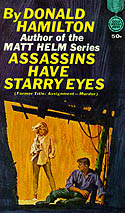
Gregory eventually discovers that Nina Rasmussen and others are out to stop the research project by elminiating the scientists involved. In a move that presages the behavior of Matt Helm, Gregory ventures into the New Mexico wilderness, allowing himself to be captured. There, with the help of a hidden knife and several guns, Gregory manages to destroy the cell of domestic saboteurs. An interesting feature of the story is the tension created by his growing affection and admiration for Nina Rasmussen, and the ultimate necessity for wiping her and her fellow saboteurs out, which Gregory accomplishes with cold-blooded efficiency.
Nineteen-sixty is a watershed year, because it was then that Hamilton was tendered a fateful opportunity. Fawcett Gold Medal had, for some while, been successfully marketing Edward S. Aaron's Assignment series that featured American espionage agent Sam Durell. Durell was an operative who worked overseas, usually in exotic locales. Fawcett was looking for a counter-agent who would work against foreign spies within the boundaries of the United States. It was suggested that the new counterspy should be an assassin, since there was no more permanent way to counter the activities of a foreign spy than to kill him.
It is worth noting here that even though Ian Fleming had been publishing the James Bond novels since the early '50s, Bond was not yet well-known in America, since none of the motion pictures had yet been filmed, nor had President Kennedy yet mentioned his affection for them to the press. In a very real sense, Helm predates Bond in the American imagination, and as critic Robin Winks has noted, stands up as a better creation, book for book, than Bond ever has.
Helm is introduced as a regular guy, remarkably like Hamilton, himself. He is happily married with children, an avid outdoorsman and hunter, and an accomplished writer and photographer. As his story opens, he and his wife are at a cocktail party in Santa Fe, New Mexico when a woman he has not seen in fifteen years, known to him only by the code-name "Tina," enters the room and gives him a secret recognition signal. Instantly, a solid citizen named Matthew Helm begins to "die," and a deadly wartime assassin known as "Eric" rises from the ashes.
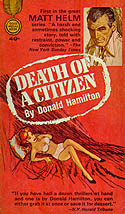
Within hours, Helm finds a young woman he met at the party dead in his study, but he is strangely unphased by the discovery. "Already I had readjusted," he tells us. "It had happened that quickly. Three hours ago I'd been a peaceful citizen and a happily married man zipping my wife's cocktail dress up the back . . . At that time, the death of a girl--particularly a pretty girl I'd met and talked with--would have been cause for horror and dismay. Now it was a minor nuisance. She was a white chip in a no-limits game. She was dead, and we'd never had much time for the dead. There were living people around who worried me a lot more."
The compelling aspect of these first two dozen pages is the effortlessness with which Helm slips back into his half-forgotten patterns of behavior. He finds himself sizing up possible antagonists, and seems to relish the possibility of testing them in some kind of contest. We begin to realize that Helm has been kidding himself for the past fifteen years. He wanted to be an ordinary citizen, to forget his past, and live a normal life, but it's all disappearing before his eyes, and ours. He's a predator, comfortable with the idea of killing, unbothered by the blatant face of death, and he's never been anything else. Helm narrates his story in such a reasonable tone, with occasional flashes of wry humor, that for a while, we don't fully appreciate the impact of the change.
Tina reappears in Helm's study, identifies herself as an American agent, and explains that the dead woman was an enemy agent bent on the murder of an important atomic scientist, who happens to be Helm's neighbor. Suspicious, Helm nevertheless agrees to assist her, and they leave in his pickup truck.
As they travel through the southwest, Helm recalls more and more memories of his wartime life, allows himself to be seduced by Tina, and falls easily into the rhythm of a counter-intelligence agent. We notice, and are disturbed by his lack of resistance, particularly in the casual manner of his adultery.
At a certain point, Helm is confronted by his old boss, a man known to him only as "Mac." Mac explains that Tina is working for the Russians, and that she was using Helm to get close enough to his neighbor to kill him. Mac, punctilious in both manner and speech, chides Helm for his gullibility. However, it is apparent to us, if not to Mac, that Helm was more than willing to be led astray.
With their cover blown, Tina and her associates decide to force Helm to commit their assassination for them, and to insure his cooperation, they kidnap his youngest daughter.
The final pages of this novel are remarkable for the depiction of Helm's mind as he ventures forth to kill his enemies. Provided with a fast car by Mac to get him where he needs to go, he walks around it, commenting "It was the ugliest damn hunk of automotive machinery I'd ever had the misfortune to be associated with . . ." He provides us with a running commentary on the car for the next two pages, just as if he were a regular joe talking cars with a buddy, instead of a man about to dive willingly and cold-bloodedly into murder.
After reaching Santa Fe, he goes to rendevous with one of Tina's associates, a man named Loris with whom he's already had a run-in. "As I came up, he was saying something. His attitude was impatient and bullying. I suppose he was asking what the hell I was doing there, and telling me what would happen to me or Betsy if I was trying to pull something . . . I didn't hear the words . . . There was nothing he had to say that I had to hear . . . I took out the gun and shot him five times in the chest."
Soon, Helm finds Tina, and systematically tortures her until she reveals the whereabouts of his daughter. He learns what he needs to know, but in an ending rife with dark irony, Helm is arranging Tina's bloody corpse to simulate a suicide when his wife walks in. Now the death of the citizen is complete. Horrified at the discovery that her husband isn't what she thought, Beth Helm leaves Matt, freeing him to return to a life that he now knows he should never have left.
In an era where paperback originals were seldom given credence as an art form and rarely reviewed, this stunning debut captured the eye of the dean of mystery critics, Anthony Boucher, who wrote in the New York Times that "Donald Hamilton . . . has brought to the spy novel the authentic hard realism of Hammett; and his stories are as compelling and probably as close to the sordid truth of espionage, as any now being told."
Helm is, perhaps, the most single-minded, and pragmatic secret agent in the genre. It isn't that Helm is incapable of tenderness or even regret, but more that for him, behaving like a professional at all times and in all ways pervades every facet of his character. It is, as Robin Winks explains, the perhaps the only sustenance of "a man wishing he could find someone to believe in."
When an enemy female agent is killed while trying to assassinate him, he bends down to talk to her in her final moments:
"I'm dying, aren't I?"
"I should hope so," I said. "If not, we'll have to send my associate back to marksmanship school."
After a shocked moment, she managed a little ghost of a laugh. "Thanks," she gasped. "Thanks for not feeling obligated to lie unconvincingly and tell me I'm going to be find, just fine."
"That bullshit is for amateurs," I said. "We're all pros here, aren't we?"
Helm often expresses admiration for a worthy opponent, as he does after outmaneuvering Jimmy Hanohano in The Betrayers:
He licked his lips. "You . . . tricked me haole!"
It was no time to apologize. He didn't want my apologies. He wanted to know that he was dying at the hands of a man, not a kid who would weep over his kills.
I said harshly, "I'm a pro, kanaka. I don't fight for pleasure, just for keeps."
He showed me his big bright grin instead. "Too bad for you, man. You'll miss a lot of fun that way, a lot of fun . . ."
Then the message got through to his brain at last and his face changed, and he pitched forward in the dirt of the cane field. . . I'd never known him, but I was going to miss him anyway.
Very often the only kinship Helm can find is with an enemy. In The Ravagers, his attempt to disarm a female enemy armed with an acid-filled glass water pistol backfires, and she is badly burned and disfigured by the acid. The agent's accomplices are holding the daughter of Helm's love interest, and he knows that the only chance he has to rescue the daughter is to force the information from the injured woman. He offers a death pill in return for her cooperation:
"I love you [Helm]. You're almost as mean as I am."
"Meaner," I said. "I'll come visit you in the hospital. See how you're coming with your left-handed Braille."
I heard Jenny stir behind me. I guess she thought I was terrible, even though it was her child I was fighting for. She didn't count here. She didn't know how it was. She wasn't a pro, like the two of us.
It is a skillful and subtle replay of the end of his marriage. He and Jenny have fallen in love, but this exchange is sufficient to wreck the budding relationship.
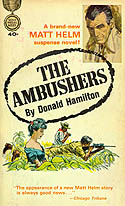
Of all the women he meets during the course of his adventures, the two with whom he experiences anything close to a relationship are his enemies. The first is Robin Rostyn, whom he first meets in Murderer's Row, and the other is the Russian agent Vadya, who makes her debut in The Ambushers.
He duels with these women several times before, inevitably, losing them to violent death. Hamilton's subtlety of technique is at its peak on these occassions, as Helm gently leaks his sorrow, remorse, and anger from behind his stoicism, and acknowledges that anyone who gets close to him may be used up by the violence swirling about him.
Like many of Hamilton's earlier protagonists, Helm has a fondness for edged weapons, even though he occasionally muses that "nowadays there's supposed to be something very underhanded and un-American about a knife." In another story in which he reveals some of his origins, he explains how he defended himself with a knife against a group of drunken college upperclassmen bent on hazing him. Helm explains:
They could have gone and had their tight little fun anywhere they damned well pleased, except in my room at my expense. I made that quite clear to them before the action started . . . As far as I'm concerned, people can either stick to polite, civilized conduct, or I'll give them jungle all the way.
In 1977 Hamilton published what many feared was the last Matt Helm novel. The Terrorizers is somewhat unique in that, for a change, the object of Helm's pursuit is a gang of American terrorists with a leftist agenda. Helm, as he often does, manages to have himself captured by the gang, then waits for the opening he needs to turn the tables on them. When it comes, the battle Hamilton describes is a skillful choreography of violence. At the end, Helm stands alone in a roomful of people he has killed, noting that "when I let up on the trigger, the silence was frightening."
For the first time in his life the horror of the fight and the pain of his own wounds is nearly overwhelming:
I was reluctant to move. I had a feeling that I would fall apart into a large number of little red squishy pieces if I tried to move. I was the last man alive in hell, a sinner myself knee deep in the burning blood of other sinners.
Now, at the end, the act of killing has become almost too much for him. As he comes to his senses enough to realize that the one person he has come to kill, the female leader, remains alive, he tells us, "I heard somebody say, "No. Go away damn you. I don't want to . . . It's enough, go away."
But once again, the predator in him, the professional, won't allow him to be defeated:
The voice was mine. But nobody cared about what I wanted. I wasn't here to satisfy my wants . . . I slipped the weapon out of the plastic case, took the caps off the scope . . . moved to the galley door . . . She was closer now. I opened the door. She saw me, stared at me, picked up the long skirts, and started to run back up the graveled road from the pier. I put the crosshairs in the proper place, applied easy pressure on the trigger, and let the weapon fire when it wanted to . . . After a while I had to sit down.
In the final scene, we find the hospitalized agent unsure of his future, and at least considering the possibility of a high-level desk job.
In the years following, Hamilton spent his time developing what might be thought of as his only "blockbuster" novel, The Mona Intercept. Reading it in the light of his earlier career, one can see virtually all of Hamilton's literary preoccupations at work. Women, both ineffectual and stalwart, are on display. Non-violent Everymen driven to violence by criminal attack and bureaucratic indifference outnumber, but do not quite supplant ruthless government agents. There are also criminals who sacrifice themselves in a noble attempt to atone for their tragic flaws. The story seems to have everything but Matt Helm, and one almost wishes he was there. Even Robin Winks had reservations, stating in his book Modus Operandi (1982) that The Mona Intercept was "a possibly unwise experiment with substantially weightier fiction."
After a five year absence, Matt Helm reappeared in The Revengers. Like The Mona Intercept which preceeded it, The Revengers is a large book with a plot more complex than the earlier stories, as are the books that follow it. This new Helm (it's hard to think of him as the original Helm, who would have to be in his late 60s by this appearance) is a bit different than the earlier one in that he is less ruthless, less willing to kill, and is a bit too sentimental about the women he meets. His love affairs, which often end badly for him, seem to take more out of him than his liaisons of the past.
His role in Mac's secret agency is changed now, too. Helm now appears more as a company troubleshooter than as Mac's favored, and most skillful assassin. These books are a bit less fulfilling than the earlier ones, if for no other reason than the sheer size of them gets in the way of the thing Hamilton was best at--building suspense and maintaining it through the final pages.
For much of his career, Hamilton has produced a body of literature that is remarkably free of formula, and a protagonist who defies easy classification. That Matt Helm is a willing killer who also loves dogs and the heroic lore of his country is a paradox that continually kept him a fresh creation over several decades of time.
Andy East, in his Cold War File (1983) estimated that more than 20,000,000 Matt Helm books had been published world-wide. The continued appearance of new titles and the retention in print of earlier ones suggests that the total may be half again as much today. Hamilton's fully realized protagonist, crisp, taut dialog, and skillfully choreographed fight scenes make him one of the best of the Gold Medal writers, and an enduring legend, both to readers and to the many writers who consider him an influence.
A Donald Hamilton Checklist
Hamilton's early hardcover appearances were in relatively short runs, so finding any of them in a collectable state may be a considerable challenge. Paperback reprints, usually in Dell Mapback editions, may also be difficult to find in mint condition, given the quality of paper and glue bindings from that era. The same may be said of the Dell First Editions, and the early Fawcett Gold Medal editions of his work. The value of paperbacks is volatile, and may differ widely from one dealer to the other.
All of the bibliographic data for this checklist was compiled by Raymond J. Peters.
Date With Darkness. New York: Rinehart, "R", Copyright 1947, by Donald Hamilton.
The Steel Mirror. New York: Rinehart, "R", Copyright 1948, by the Curtis Publishing Company. Copyright 1948, by Donald Hamilton.
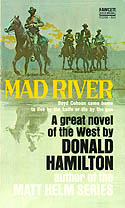
Murder Twice Told. New York: Rinehart, "R", Copyright 1947, 1949, 1950 by Donald Hamilton. (includes the novellas "The Black Cross" and "Deadfall")
Smoky Valley. New York: Dell, April 1954. (Dell First Edition # 18)
Night Walker. New York: Dell, August 1954. (Dell First Edition # 27)
Line of Fire. New York: Dell, January 1955. (Dell First Edition # 46)
Mad River. New York: Dell, February 1956. (Dell First Edition # 91)
Assignment: Murder. New York: Dell, October 1956. (Dell First Edition # A123)
[later reissued as Assassins Have Starry Eyes. Gold Medal # k1491]
The Big Country. New York: Dell, April 1958. (Dell First Edition # B115)
Death of a Citizen. Greenwich, CT.: Fawcett, January 1960. (Fawcett Gold Medal # 957)
The Man From Santa Clara. New York: Dell, July 1960. (Dell First Edition # 817)
[later reissued as The Two-Shoot Gun. Fawcett Gold Medal # R2492]
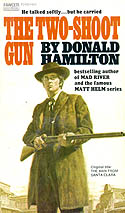
The Wrecking Crew. Greenwich: Fawcett, August 1960. (Fawcett Gold Medal # 1025)
Texas Fever. Greenwich: Fawcett, September 1960. (Fawcett Gold Medal # 1035.
Later republished in hardcover by Walker, c1981 10 9 8 7 6 5 4 3 2 1)
The Removers. Greenwich: Fawcett, March 1961. (Fawcett Gold Medal # s1082)
The Silencers. Greenwich: Fawcett, Febrary 1962. (Fawcett Gold Medal # s1194)
Murderer's Row. Greenwich: Fawcett, October 1962. (Fawcett Gold Medal #s1246)
The Ambushers. Greenwich: Fawcett, August 1963. (Fawcett Gold Medal # k1333)
The Shadowers. Greenwich: Fawcett, February 1964. (Fawcett Gold Medal # k1386)
The Ravagers. Greenwich: Fawcett, 1964. (Fawcett Gold Medal # k1452)
The Devastators. Greenwich: Fawcett, 1965. (Fawcett Gold Medal # d1608)
The Betrayers. Greenwich: Fawcett, November 1966. (Fawcett Gold Medal # d1608)
Iron Men and Silver Stars (editor). Greenwich: Fawcett, 1967. (Fawcett Gold Medal # d1821) [includes the first appearance of Hamilton's short story, "The Guns of William Longley"]
The Menacers. Greenwich: Fawcett, 1968. (Fawcett Gold Medal # d1884)
The Interlopers. Greenwich: Fawcett, May 1969. (Fawcett Gold Medal # T2073)
On Guns and Hunting. Greenwich: Fawcett, September 1970. (Fawcett Gold Medal # T2299)
The Poisoners. Greenwich: Fawcett, March 1971. (Fawcett Gold Medal # T2392)
The Intriguers. Greenwich: Fawcett, January 1973. (Fawcett Gold Medal # M2659)
The Intimidators. Greenwich: Fawcett, March 1974. (Fawcett Gold Medal # P2938)
The Terminators. Greenwich: Fawcett, April 1975. (Fawcett Gold Medal # P3214)
The Retaliators. New York: Fawcett, August 1976.
The Terrorizers. New York: Fawcett, September 1977.
The Mona Intercept. New York: Fawcett, December 1980.
Cruises with Kathleen. New York: David McKay Company, c1980. 10 9 8 7 6 5 4 3 2 1
The Revengers. New York: Fawcett, November 1982.
The Annihilators. New York: Fawcett, August 1983.
The Infiltrators. New York: Fawcett, June 1984.
The Detonators. New York: Fawcett, July 1985.
The Vanishers. New York: Fawcett, August 1986.
The Demolishers. New York: Fawcett, November 1987.
The Frighteners. New York: Fawcett, May 1989.
The Threateners. New York: Fawcett, September 1992.
The Damagers. New York: Fawcett, November 1993.
© Robert E. Skinner. Reprinted with permission of the author.
Robert E. Skinner, a regular contributor to Firsts, lives in New Orleans, and is the author of the novel Skin Deep, Blood Red, and the forthcoming Cat-Eyed Trouble.
If you would like to contact Mr. Skinner, his e-mail address is rskinner@mail.xula.edu.


